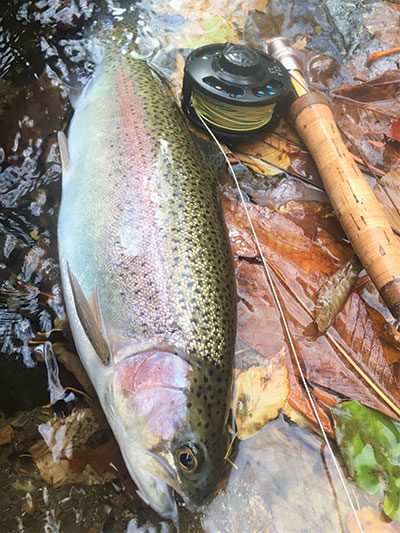We welcome October’s fall colors and especially its cooler water. This is truly our trouting “second season,” as wild trout rejuvenate and Delayed Harvest season kicks off in North Carolina, with Georgia DH right behind on November 1. What many fly fishers do not welcome is leaf-fall, with leaves and twigs being more common catches than anything with fins.
Well, Unicoi Outfitters has a few tips to help you navigate the instream debris fields and tempt a few more trout. Our two themes are “simpli-fly” and “stand out.” First, simplify your terminal tackle to provide the least possible hang-on spots for leaves and twigs. Use a nice, tapered leader with no tippet knotted to its end. If you must add some tippet, add just one piece so there’s only one additional knot in your mono. Second, drop the droppers and simpli-fly. Use just one fly knotted to the end of your leader. The fewer knots and hook points, the fewer attachment points for instream debris.
Next, simplify by casting short, no farther than 15-20 feet. Avoid crossing currents with hero shots, which will splay extra fly line on the water and channel a bushel of leaves toward your fly. Last, go with the flow. This is not the time to be stripping streamers. Instead, cast your fly upstream and let it drift back to you at the same speed and in the same current lane as your adversarial vegetation. You’ll still catch plenty of poplar leaves, but nowhere near the bushels that you would with dropper flies, long casts, and energetic retrieves.
Our second theme is to stand out. Your bug must distinguish itself from all of the aquatic clutter, both on the surface and in the water column. First, try a big, loud, meaty dry fly. Since it’s October, guess what our favorite color is? Yep, orange! Try a #12 orange stimulator or elk hair caddis. After all, this is the season for October caddis to hatch. They’re usually a very sparse hatch, but their ample calories have fall trout on the lookout for them.

Years ago, we discovered the worm’s effectiveness on some big (supplementally fed), wild, river rainbows. We have no idea why they were so effective in the crystal-clear waters. Maybe it was because they looked like fish food instead of forest clutter. All we know is that the worms worked!
Try these tips when the October winds deliver next year’s food supply: leaves to fuel the stream ecosystem. Simpli-fly your rig and pick a stand-out fly to turn your leaf-fall frustration into Halloween treats.
You can find Jeff Durniak at Unicoi Outfitters. Stop in or call the Helen shop at (706-878-3083) or our Clarkesville store on the square (706-754-0203) if we can help you further. After all, we are pretty darn good trouting caddies!
